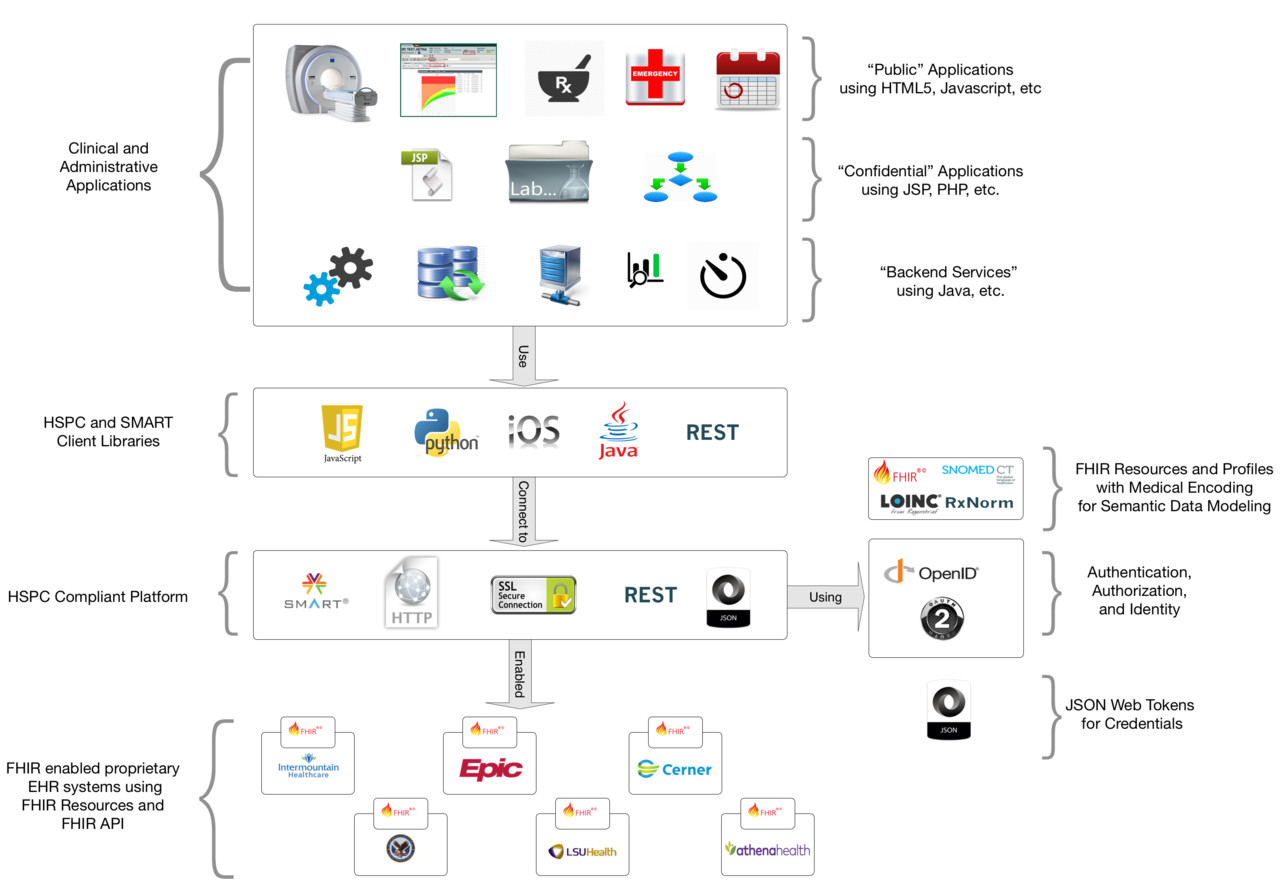Logica Technical Specification
Introduction
The Logica technical specification describes the platform, technologies, and tiers of the Logica ecosystem.
Tiers
Clinical and Administrative Applications
Logica compliant applications use standards defined by the SMART on FHIR specification for authentication, authorization, and launch context. These applications can be embedded in the EHR workflow by launching from within the EHR, or may run as a pre-authorized backend service. See App Developer's Guide for JavaScript and Java Client examples. Logica compliant applications use FHIR for semantically interoperable data exchange.
Logica and SMART Client Libraries
Logica provides a Java Client library for the SMART specification, and the SMART team provides JavaScript, Python, and iOS client libraries. In addition, FHIR defines a REST API for resource operations.
Logica Compliant Platform
An Logica compliant platform is an EHR that supports technologies chosen by Logica. These technologies include:
- SMART on FHIR for authentication, authorization, and launch context
- HTTPS for transport
- REST for FHIR resource API
- JSON for transport serialization (in favor of XML)
- FHIR terminology specification for medical encoding
- JWT for credentials
FHIR enabled proprietary EHR systems
Proprietary EHR systems are able to be Logica compliant by providing authentication and authorization from the SMART on FHIR specification and resources by the FHIR specification. Our Logica Reference Implementation is a fully functional example of an Logica compliant EHR that may be used as a test system for application developers, or may be used as an example for EHR platform developers. Our Logica Reference Implementation provides an authorization server and a resource server together on the same Apache Tomcat instance, but co-resident deployment is not required for an EHR.
Industry Standards
The Logica has identified industry standards that are to be used for Logica compliant platforms and applications.
Standard | Summary |
|---|---|
FHIR® – Fast Healthcare Interoperability Resources is a next generation standards framework created by HL7. FHIR combines the best features of HL7's Version 2, Version 3 and CDA® product lines while leveraging the latest web standards and applying a tight focus on implementability. | |
SMART on FHIR is a set of open specifications to integrate apps with Electronic Health Records, portals, Health Information Exchanges, and other Health IT systems. | |
A universal code system for tests, measurements, and observations | |
RxNorm provides normalized names for clinical drugs and links its names to many of the drug vocabularies commonly used in pharmacy management and drug interaction software, including those of First Databank, Micromedex, MediSpan, Gold Standard Drug Database, and Multum. By providing links between these vocabularies, RxNorm can mediate messages between systems not using the same software and vocabulary. | |
SNOMED CT (Systematized Nomenclature of Medicine--Clinical Terms) is a comprehensive clinical terminology, originally created by the College of American Pathologists (CAP) and, as of April 2007, owned, maintained, and distributed by the International Health Terminology Standards Development Organisation (IHTSDO), a not-for-profit association in Denmark. The CAP continues to support SNOMED CT operations under contract to the IHTSDO and provides SNOMED-related products and services as a licensee of the terminology. | |
OAuth 2.0 is the next evolution of the OAuth protocol which was originally created in late 2006. OAuth 2.0 focuses on client developer simplicity while providing specific authorization flows for web applications, desktop applications, mobile phones, and living room devices. | |
OpenID Connect 1.0 is a simple identity layer on top of the OAuth 2.0 protocol. It allows Clients to verify the identity of the End-User based on the authentication performed by an Authorization Server, as well as to obtain basic profile information about the End-User in an interoperable and REST-like manner. | |
The Hypertext Transfer Protocol (HTTP) is an application protocol for distributed, collaborative, hypermedia information systems. HTTPS (also called HTTP over TLS, HTTP over SSL, and HTTP Secure) is a protocol for secure communication over a computer network which is widely used on the Internet. | |
JSON (JavaScript Object Notation) is a lightweight data-interchange format. | |
JSON Web Token (JWT) is a compact URL-safe means of representing claims to be transferred between two parties. The claims in a JWT are encoded as a JSON object that is digitally signed using JSON Web Signature (JWS). |
